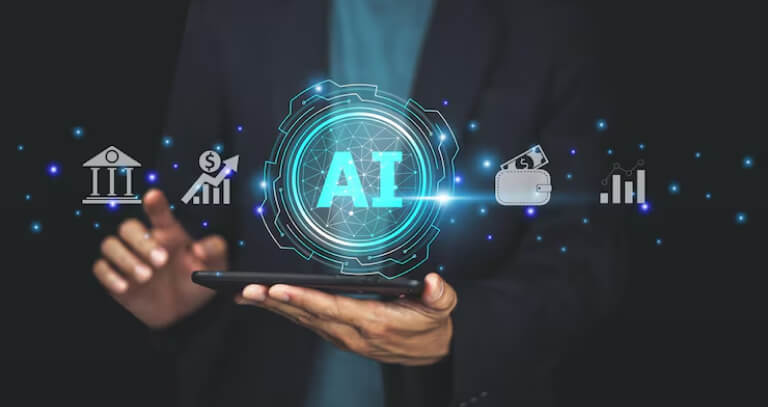How Does AI Reduce Costs In Healthcare?
Ditstek Blogs
Despite being one of the most fundamental human rights, Healthcare is still not accessible to a large part of the world. Even in areas where it can be physically accessed, patients face the debilitating dilemma of opting for the crucial care services they need by going bankrupt or surviving in this crushing economy without adequate care for their health. Who would have thought that even after so much advancements in the fields of science, healthcare, and technology, affording patient care would be the number one issue in the modern world?
Why is healthcare still inaccessible for most in 2024? Why are healthcare prices so high? What are the Gaps? What solutions are needed? How does AI come into play? How can healthcare providers make medical support accessible for patients? And most importantly, How can AI save the costs in Healthcare? To get answers to these questions and many more, keep on reading.
Why are Healthcare Costs so High?
The medical industry has progressed significantly in terms of new age treatments and diagnostic processes, but it took a lot of money into research, engineering, and resource allocation to bring about this progress. Not to forget these new age technologies are expensive to use and operate, so naturally the cost of quality care would increase as well.
Apart from this, there are several other factors that make healthcare so expensive and inaccessible:

- Expensive Treatments and Medications
Due to the increased privatization of medical care facilities and pharmaceutics, the financial aspects of healthcare have become fairly complex to regulate. And so, in the name of exclusive services or latest medicines, patients have to pay inflated prices for these services. To be fair, some amount of these spiked charges are justified due to the expensive nature or limited availability of resources leveraged to dispense these services. But how much is too much?
- Chronic Diseases & Declining Health Index
The biggest challenge in patient care is to be able to provide prolonged support for those suffering from chronic diseases. The perpetual nature of chronic disease management healthcare services leads to higher costs and billing. Moreover the health index of our population has been consistently deteriorating due to sedentary lifestyles, increased stress, and rise in mental health ailments resulting in more people needing treatment. The basic disparity between supply and demand of healthcare services also accounts for surcharged prices.
- Prolonged Diagnosing & Over treatment
The prognosis for any ailment is crucial in dispensing quality and effective relief to those seeking it. A significant contributor to healthcare costs is the diagnostic process where multiple tests are conducted to get to the root cause. While sometimes healthcare providers carry out an extensive diagnostic process due to their malicious interest in running the bills up, it is mostly done to ensure accuracy of the diagnosis and safety of the patient from any related symptoms. Similarly when the treatment course is supplemented with several defensive or precautionary steps, medicines etc, apart from the core treatment for the ailment, it increases the costs for the patient.
- Administrative Inefficiencies
Healthcare professionals have to keep up with mountains of paperwork and administrative activities to ensure their patients are receiving the best care. Tackling all that patient history data, medical records, prescription dosages, and whatnot is a very laborious, detail-oriented, and tiring task. On top of that it needs to be centralized so all relevant parties have access to all the information. This logistically crucial and perhaps the most time-consuming task also accounts for the most money-bleeding responsibility for caregivers.
Need a Robust Healthcare Solution Integrated With Trending Technologies?
Revolutionize your healthcare business with our seamless healthcare software development services. Our team harnesses trending technologies to build advanced platforms for healthcare providers.
What is Needed to Reduce Healthcare Costs?
Now that we know the root causes behind the skyrocketing healthcare costs, it is apparent that a resolution for this is needed, that too immediately. The solution lies in technology. But how can technology reduce healthcare costs ? We’ll get to that in a moment. First, let’s understand what are the areas we need to improve to reduce the costs.
Efficiency Improvements:
As the leading cost booster in healthcare, the administration and operation of healthcare providers needs to be optimized for maximum efficiency and accuracy. The scope for manual errors is pretty slim when we’re talking about someone’s life!
Preventive Care & Early Detection:
The most obvious way to avoid hospital bills is to avoid ending up in one altogether! With consistent health monitoring and treating an ailment before it gets big enough to need complex treatment. This would also help detect untreatable diseases early on when there’s still a chance of recovery.
Personalized Medicine:
Remembered when we talked about over-treatment? Let’s revisit that for a moment. If instead of putting all patients with similar diseases on the same treatment plan, we put each patient on a custom made plan and eliminate all the extra measures, the costs associated will drop significantly. But the challenge here would be the meticulous process of doing so.
Technological Advancements:
This one is pretty straightforward. The more we’ll be able to advance the technology, the better and well-suited treatments we’ll be able to dispense. Plus progress in the technological aspects of healthcare would help us reduce reliance on current cost-heavy approaches for treatments.
Also Read: How To Develop Custom Behavioral Health EHR Software
How Can AI Save the Costs in Healthcare?
Many people can’t really place AI and medical care together, this is because of a common misconception that using AI would mean we’re trying to replace healthcare providers. This couldn’t be any further from the truth!
Despite the popular notion that AI aims to steal people’s jobs, the truth and our motto is that AI helps people perform better at their jobs! In this scenario, the numerous benefits of using AI in healthcare can be availed by caregiving professionals to do it at a larger scale and in a more impactful manner.
Enhanced Patient Satisfaction with Reduced Costs!
Witness the transformative impact of AI for your healthcare business with DITS’ healthcare software solutions.
In fact, it is predicted that AI and machine learning will likely reduce healthcare costs by $13 billion by the year 2025. Seems like we have your attention! Now Let’s delve deeper and understand how does AI reduce costs in healthcare.
AI for Operational Efficiency & Administration
A leading contributor in costs pertaining to healthcare is Administration and Operations. In fact, according to recent studies on healthcare expenditure in various countries, the US spends about $496 billion every year on billing and insurance, which is double the amount of money actually needed. This means we’re precisely throwing $248 billion dollars down the drain every year!
To resolve this, AI can be a great tool by reducing load on human resources by automating several admin processes such as appointment scheduling, billing, insurance claims processing, patient data management etc. Not only can it save time by combing through years of research and data almost instantly, but it also saves additional costs by eliminating the scope of human errors and frauds.

All in all, it is suggested that up to 45% of the administrative and operational tasks can be automated by AI thereby reducing the concerned costs by almost half.
AI for Diagnostics and Early Detection
AI’s precision and accuracy while analyzing X-rays, MRIs, CT scans, and other medical images comes into play when we talk about improving our healthcare system’s diagnostic processes and results. But how does AI reduce costs with this? While the benefit of improved accuracy is enough to implement AI in Diagnostics, the added benefit of decreasing human dependency for this process helps cut down the monetary investments required for it.
By leveraging AI and ML (Machine Learning), genetic markers for various mutations can be analyzed in addition to biomarkers. This helps it predict certain ailments even before they exhibit any symptoms and also gauge the probability of them occurring by leveraging genetic information and cross-referencing them with disease history and research; further decreasing the treatment costs for patients and healthcare providers alike. So much so, that about 50% of the hospital admissions can be avoided by catching such ailments ahead of time.
AI for Personalized Treatment & Medicine
For the longest time, health sciences have revolved around finding generalized treatment for all suffering from a certain disease so as to have a guiding resource on how to approach patient care. But this was the case because it was never logistically possible to tailor treatment plans to each individual. This is now possible with AI.
With AI, healthcare professionals don’t need to go over the extensive data pertaining to a patient's generational medical history, environmental factors, genetic predispositions and then refer it with the vast information and research on their disease to develop a treatment plan for the said patient. AI can do this in minutes and even analyze the patterns to predict any risk of catching certain decisions with more precision.
This not only allows for a more patient-centric treatment, but also saves time and money which would have otherwise been spent in extensive testing and multiple medications prescribed as preventions from certain side effects that may or may not occur.
Upgrade your healthcare business with our innovative software solutions. Let us help you stay ahead with the latest technology tailored for healthcare providers.
AI for Telehealth & Remote Monitoring
Another major obstacle in making healthcare accessible for all is the sheer size of the world and not enough funds to build patient care centers in every town, city and state. With Remote patient monitoring, even patients in remote areas can access quality healthcare from qualified professionals. Moreover it allows people with mental disorders, or those who just need consultation to receive care without entering the premises of a medical facility.
This has multifaceted benefits for both patients and doctors like:
- Decreased footflow in care facilities helping in easy and economic management of emergent patients who cannot be treated virtually
- Virtual patient monitoring allows patients to save time and money in commuting and waiting in lines for tests, results,and prescriptions.
- Having a telehealth with required features allows patients and healthcare providers to access all the data from their screens thus eliminating extra paperwork and chunky patient history files.
- It also allows for better prescription management as such platforms safeguard your prescription information, remind you for refills, and even signal your pharmaceutical provider to deliver your medications before you run out.
- AI powered remote monitoring maintains distinct and verified records of prescribed medications and leverages the patient history, development of the disease, and current progress of the patient to adjust the medication dosages regularly. This could save about $16 billion simply by reducing human errors in medication dosing.
By leveraging AI to build custom remote patient monitoring platforms, many healthcare providers are already on their way to unleashing tremendous savings and enhancing their patient satisfaction and outcomes.
SAAS-Based IoT Remote Patient Monitoring Platform!
If you’re a healthcare provider and want to do the same for your patients,check out this remote patient monitoring platform we custom-made for our client and witness how can AI save costs in healthcare first-hand.
AI for Research & Drug Development
For a drug to reach from bench to bedside, it takes about 12-15 years and over $2.5 billion USD per drug! This very extensive process occurs in 3 key phases: The discovery phase, The Pre-clinical phase, and the Clinical phase. And even after investing a decade and billions of dollars into it, 9 out of every 10 drugs that go for approval are denied from entering the market.
The deeply concerning statistics highlight why the world was hit drastically when COVID hit. After all, if a pandemic hits the world in 2020, can people wait until 2035 to get access to drugs that eliminate it entirely? This is why it is of utmost importance to shorten the drug development cycle. Not to forget the insane amount of money that goes into funding the research and development for years on end!
Now that we understand the need of doing so, it’s time to delve into how does AI reduce costs in healthcare, particularly in research and drug development.
AI can be leveraged at various steps of the drug development process from drug discovery to product management when it hits the shelf. It can shorten the drug discovery phase by helping in research and decision making in the formulation process and thus improving the overall life cycle of the product. AI’s core competency of quickly analyzing data can be used to collect clinical data for future research and even contribute towards facilitating personalized medicine for patients.
Needless to say, AI cuts down healthcare costs in multiple ways by reducing human dependency and consequently the monetary investment for the same. By shortening the entire process, it simply reduces the amount of money being spent for years on end, additionally, by diminishing human errors, it saves costs by avoiding wastage of money in futile attempts.
All in all, studies indicate that the cost of finding new drugs can be reduced by 70% with AI.
Are there any Limitations of using AI in Healthcare?
Despite the countless benefits of AI in reducing healthcare costs, there remains a fear amongst professionals and patients alike. They often wonder what are the harms of using AI in healthcare? We believe that AI can and is effectively revolutionizing healthcare as we know it, however there can be some limitations of using it.
For one, using AI may raise some concerns about data privacy and application security. As patient data is highly sensitive, it is of utmost importance to record it on a secure platform. There could also be a potential for AI bias to some extent as AI will ultimately reflect the existing prejudice and bias in the medical industry into its processes as well. Plus there could be some regulatory hurdles in the implementation of AI in healthcare.
That being said, one of the key advantages of AI is that it is highly customizable and so by taking some extra measures, we can diminish these limitations to a great extent.
How DITS can Help you Leverage AI for Healthcare
Now that understanding how does AI reduce costs in healthcare doesn’t seem so daunting anymore, here’s what you need to do as a healthcare provider- Act on it! The benefits of AI in healthcare are prominent , apparent, and too good to pass up. So, it’s time you scale your care services with AI. How to do that? We’ve got you covered!
As a leading healthcare software development company, DITS is experienced in building custom and comprehensive solutions for our clients in the medical industry. We’ll help you streamline your processes, build robust solutions for remote patient monitoring, and use AI to reduce errors and costs thereby maximizing your output and improving patient satisfaction.
You can check out this comprehensive telehealth platform we customized for a very special client. Our vast tech stack and skilled developers curated a seamless platform boasting top-notch user interface & user experience. Read all about the innovative features and integrations to understand this world-class solution better.
Talk to us today and get started on your journey!
FAQs
How AI can be used to reduce costs?
For most industries, AI can be immensely effective in cost reduction as it cuts down operational expenses and also diminishes errors caused by humans. AI also streamlines resource utilization and can be very helpful in automating key processes. Particularly for healthcare, it has proven merits in cutting down research costs, patient information storing and updating costs and many more.
How can technology reduce healthcare costs?
Healthcare providers can use AI to reduce costs and enhance overall efficiency by automating most administrative tasks. This allows them to lessen the workload on professionals and reduce the financial investment required. Furthermore, AI reduces anomalies and errors in processing often made by humans which also decreases the operational costs for healthcare.
How does healthcare benefit from AI?
Healthcare is significantly impacted by AI in a positive way. AI can be leveraged in healthcare to streamline the humongous task of data collection and management. It can further be of use in research for drug production, clinical trials, and overall improving the operational structure for eligibility and screening for said trials.
How AI can lower the costs of clinical trials?
AI can help expedite the patient recruitment timeline for clinical trials by curating eligibility criteria of sorts while adhering to the safety standards required. The patient demographic research and analysis can also be streamlined with AI. Overall, AI has huge time and cost saving benefits for both clinical trial design and operations
How is AI going to change healthcare?
AI’s role in healthcare is expected to make fundamental shifts in how we diagnose and treat diseases. With extensive benefits and real-time operability, AI will help healthcare providers dispense quality care to people all across the world and even help transform the research and disease prevention processes that we follow today.

Nidhi Thakur
With more than 19 years of experience - I represent a team of professionals that specializes in the healthcare and business and workflow automation domains. The team consists of experienced full-stack developers supported by senior system analysts who have developed multiple bespoke applications for Healthcare, Business Automation, Retail, IOT, Ed-tech domains for startups and Enterprise Level clients.
Recent Posts
Get in touch





.jpg)



 Calgary | Edmonton | Vancouver | Toronto
Calgary | Edmonton | Vancouver | Toronto Marriott Downtown Hotel | Calgary
Marriott Downtown Hotel | Calgary